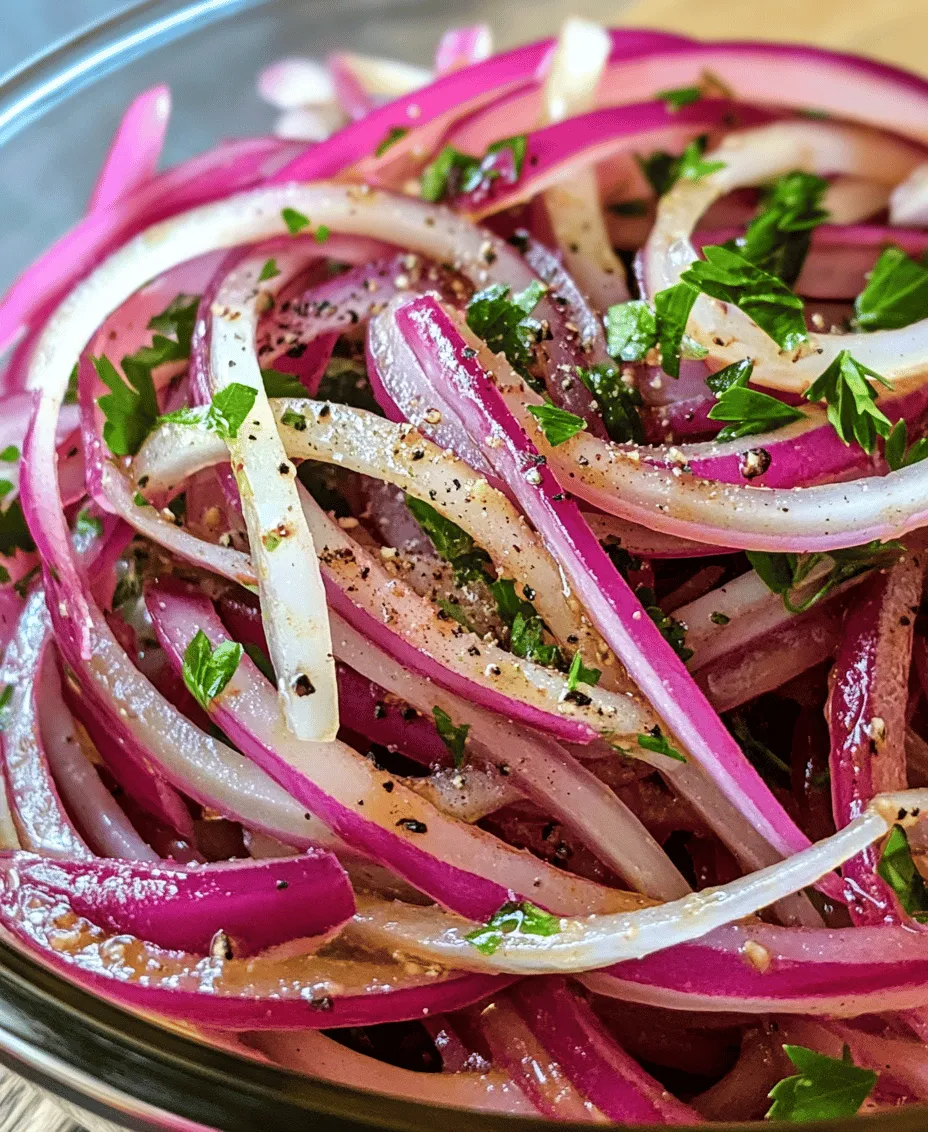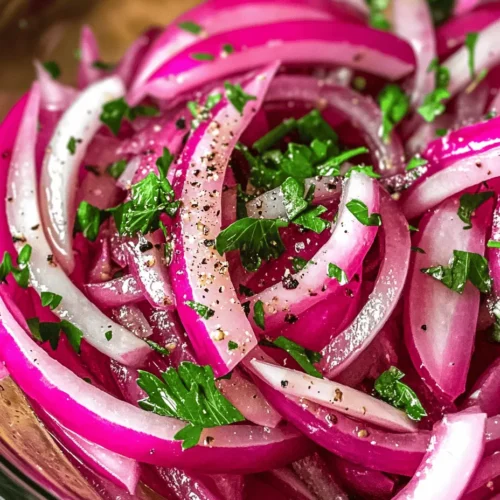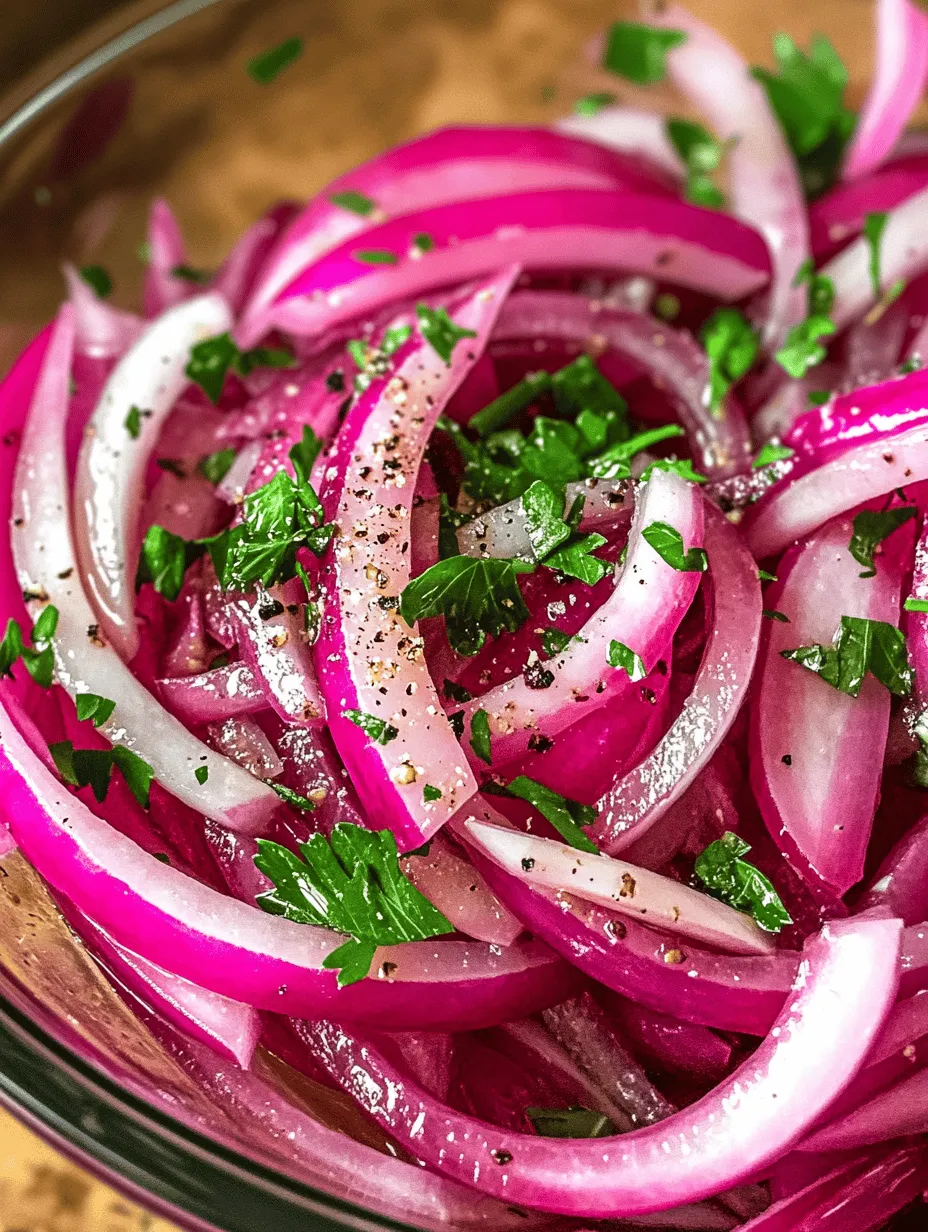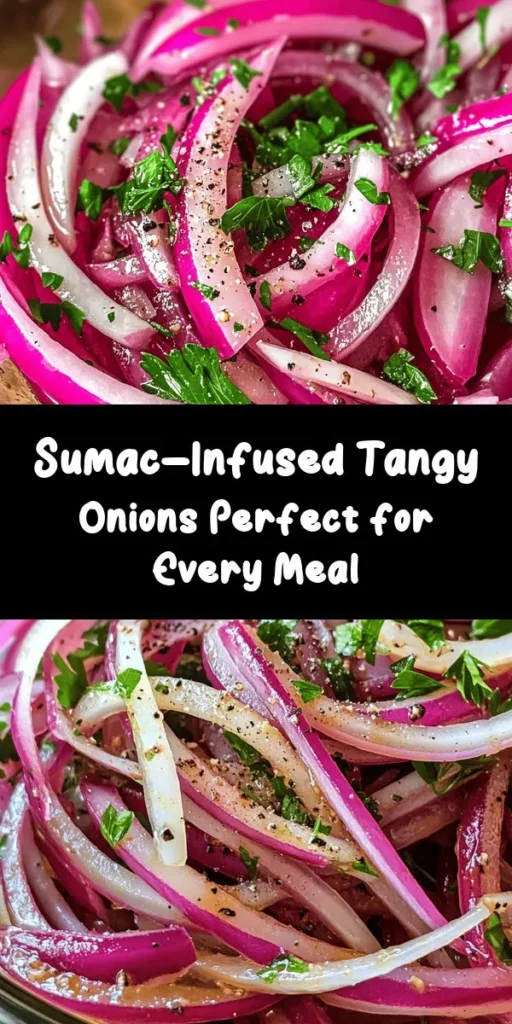Introduction
In the culinary world, tangy flavors have a special place, adding brightness and depth to a variety of dishes. They can transform simple ingredients into extraordinary meals, providing that perfect balance between savory and sour. One spice that embodies this tangy essence is sumac, a vibrant red spice with a tart, lemony flavor profile. With its roots in Middle Eastern cuisine, sumac has gained popularity around the globe, celebrated for its unique taste and health benefits.
One delightful way to incorporate this distinctive spice into your cooking is through Tangy Sumac Onions. This simple yet flavorful preparation not only enhances the taste of your meals but also adds a pop of color and freshness that can elevate any dish. Whether you’re serving it alongside grilled meats, tossing it into salads, or using it as a topping for sandwiches, Tangy Sumac Onions are versatile enough to complement an array of cuisines.
In this article, we will delve into the ingredients that make this dish shine, followed by a detailed preparation process to help you create these zesty onions in your own kitchen.
Understanding the Ingredients
Red Onions
Red onions are the star of this recipe, known for their sharp, slightly sweet flavor that becomes mellower when marinated. These onions are not just flavorful but also packed with nutritional benefits. Rich in antioxidants, particularly quercetin, red onions can help reduce inflammation and boost heart health. They also contain vitamins C and B6, and minerals like potassium and manganese, making them a healthy addition to any meal.
The vibrant purple hue of red onions also makes them visually appealing, adding color to your dishes. When used in Tangy Sumac Onions, they provide a crunchy texture that pairs beautifully with the marinating ingredients, enhancing the overall eating experience.
Sumac Spice
Sumac is a spice that many might not be familiar with, yet it holds a significant place in various culinary traditions, especially in Middle Eastern cooking. It is derived from the dried and ground berries of the sumac plant, which is native to the Mediterranean region. The flavor of sumac is often described as tangy and lemony, making it a perfect complement to dishes that benefit from a citrusy kick.
In addition to its culinary uses, sumac is also known for its health benefits. It is rich in antioxidants, which can help combat oxidative stress in the body. Moreover, sumac has anti-inflammatory properties and may aid in digestion. By incorporating sumac into your cooking, you not only elevate the flavor profile of your dishes but also contribute positively to your health.
Olive Oil
Olive oil is a key ingredient in many dressings and marinades, and its role in Tangy Sumac Onions is no different. Known for its heart-healthy monounsaturated fats, olive oil is praised for its ability to lower bad cholesterol levels and reduce the risk of heart disease. When combined with the other ingredients in this recipe, olive oil acts as a base that helps meld the flavors together while adding a rich, fruity undertone.
Using high-quality extra virgin olive oil can further enhance the taste of your Tangy Sumac Onions, providing a smooth mouthfeel that complements the sharpness of the onions and the tanginess of the sumac.
Apple Cider Vinegar
Apple cider vinegar (ACV) is another essential component of this recipe, contributing acidity that brightens the overall flavor. ACV is not only a flavor enhancer but also boasts numerous health benefits. It is known to help regulate blood sugar levels, support weight loss, and improve digestion.
In the preparation of Tangy Sumac Onions, apple cider vinegar works in tandem with the onions to create a balanced flavor profile. The acidity helps to soften the onions, making them more palatable while allowing the other ingredients to shine through.
Lemon Juice
Lemon juice plays a critical role in balancing the flavors of the Tangy Sumac Onions. Its bright acidity complements the tanginess of the sumac and the sharpness of the onions, creating a harmonious blend of flavors that is refreshing and appetizing. Lemon juice not only enhances the taste but also adds a layer of freshness to the dish.
Additionally, lemon juice is rich in vitamin C, an important antioxidant that supports the immune system and promotes skin health. By incorporating lemon juice into this recipe, you are not only enriching the flavor but also adding nutritional value.
Fresh Parsley
Finally, fresh parsley is the finishing touch that brings the Tangy Sumac Onions together. This herb adds a burst of freshness, both in flavor and appearance. Parsley is loaded with vitamins A, C, and K, as well as beneficial compounds like flavonoids and carotenoids, making it a nutritious addition to your meals.
In this recipe, parsley provides not only a pop of color but also a mild, herbaceous flavor that balances the tangy elements of the dish. The combination of parsley with the other ingredients creates a well-rounded and visually appealing preparation that can elevate your dining experience.
The Preparation Process
Creating Tangy Sumac Onions is a straightforward process that can be broken down into a few simple steps. This recipe is designed to be easily replicated, ensuring that you can enjoy this delightful addition to your meals at home.
Step 1: Slice the Onions
The first step in preparing Tangy Sumac Onions is to slice the red onions. Begin by peeling the onions and cutting them in half from root to tip. Place the flat side down on your cutting board and slice them thinly into half-moon shapes. The thickness of the slices can affect the flavor and texture of the final dish—thinner slices will become softer more quickly, allowing them to absorb the flavors of the marinade, while thicker slices will retain some crunch.
Step 2: Salt the Onions
Once the onions are sliced, place them in a bowl and sprinkle them generously with salt. The salt serves two purposes: it enhances the flavor of the onions and helps draw out moisture, which softens them as they marinate. Let the salted onions sit for about 10-15 minutes. You’ll notice that they will begin to release water, creating a natural brine that will further enhance the flavor of your Tangy Sumac Onions.
Step 3: Prepare the Dressing
While the onions are sitting, it’s time to prepare the dressing. In a small bowl, combine olive oil, apple cider vinegar, lemon juice, and sumac. The ratio of these ingredients can be adjusted to suit your taste preferences, but a good starting point is 2 tablespoons of olive oil, 1 tablespoon of apple cider vinegar, 1 tablespoon of lemon juice, and 1 tablespoon of sumac. Whisk the ingredients together until they are well combined.
Step 4: Combine Ingredients
After the onions have released some of their moisture, drain any excess liquid if necessary. Then, add the sliced onions to the dressing and toss them gently to ensure that every slice is coated in the flavorful mixture. At this point, you can also chop fresh parsley and add it to the bowl, giving everything a final toss to combine.
Step 5: Marinate
For the best flavor, let the Tangy Sumac Onions marinate for at least 30 minutes before serving. This allows the onions to absorb the tangy dressing fully, resulting in a deliciously flavorful condiment. If you have the time, letting them marinate for a few hours or even overnight in the refrigerator will deepen the flavors even further.
The result will be perfectly tangy onions that are not only delicious but also versatile enough to enhance a variety of dishes. Whether you choose to serve them on their own, as a topping, or as part of a salad, Tangy Sumac Onions are sure to impress.
With these initial steps laid out, you are well on your way to creating a vibrant and tangy addition to your meals. The combination of red onions, sumac, and fresh herbs will not only tantalize your taste buds but also provide a nutritious boost to your dining experience. Stay tuned for more tips and variations on how to make the most of this delightful recipe!

The Significance of Marinating Time for Flavor Infusion
When preparing Tangy Sumac Onions, marinating time is crucial for achieving that perfect balance of flavors. Allowing the onions to soak in the tangy mixture of sumac, olive oil, and vinegar not only enhances their taste but also mellows their natural sharpness. A minimum of 30 minutes is recommended for the onions to absorb the sumac’s tartness fully, but for optimal results, consider marinating them for several hours or even overnight. This extended period allows the flavors to deepen, resulting in a more complex and satisfying dish.
Flavor Profile of Tangy Sumac Onions
The flavor profile of Tangy Sumac Onions is a delightful interplay of tanginess from the sumac, sweetness from the onions, and richness from the olive oil. Sumac, a staple in Middle Eastern cuisine, brings a unique citrusy tartness that elevates the dish. Its bright, zesty notes harmonize beautifully with the natural sweetness of the onions, creating a taste experience that is both refreshing and vibrant.
Sumac’s aromatic qualities are a standout feature, contributing to the dish’s overall appeal. It has a slightly fruity aroma that can remind one of lemon, making it an excellent seasoning for various dishes. In Middle Eastern cooking, sumac is often used to enhance the flavors of grilled meats, salads, and dips, showcasing its versatility and importance in this culinary tradition.
When served, Tangy Sumac Onions can significantly enhance the flavors of accompanying food. They serve as a bright counterpoint to rich or heavy dishes, cutting through the fat and adding a layer of complexity. Whether you’re serving them alongside grilled meats or incorporating them into salads, they provide a refreshing contrast that makes every bite more enjoyable.
Serving Suggestions
Tangy Sumac Onions are incredibly versatile and can be incorporated into meals in numerous delightful ways. Here are some ideas to inspire your culinary creativity:
– As a Side Dish to Grilled Meats: These onions make an excellent accompaniment to grilled chicken, lamb, or beef. Their tangy flavor complements the smoky char of grilled meats, enhancing your meal with a burst of freshness. Simply serve them on the side or atop the meat for an added flavor dimension.
– Topping for Flatbreads and Sandwiches: Use Tangy Sumac Onions as a vibrant topping for flatbreads, wraps, or sandwiches. They add a zesty crunch that can elevate even the simplest of meals. Pair them with hummus, tzatziki, or your favorite protein for a satisfying and flavorful dish.
– Addition to Salads for a Refreshing Twist: Tossing these onions into a salad can provide an exciting flavor boost. They work particularly well in grain-based salads, such as quinoa or bulgur, adding both texture and taste. Combine them with fresh greens, cherry tomatoes, and a light vinaigrette for a refreshing summer salad.
– Pairing Recommendations with Specific Cuisines: Tangy Sumac Onions shine in various culinary contexts. They pair beautifully with Mediterranean dishes, offering a burst of flavor alongside tabbouleh, falafel, or grilled vegetables. Additionally, they can enhance Middle Eastern-inspired meals, complementing the spices of dishes like shawarma or kebabs.
Health Benefits of the Ingredients
The ingredients in Tangy Sumac Onions not only contribute to the dish’s flavor but also offer numerous health benefits:
– Onions: Packed with antioxidants and essential nutrients, onions are known for their health-promoting properties. They contain quercetin, which has anti-inflammatory and antioxidant effects, and are rich in vitamins C and B6. Eating onions may support heart health, improve digestion, and boost the immune system.
– Sumac: This unique spice is not only flavorful but also beneficial for health. Sumac is high in antioxidants, which can help combat oxidative stress in the body. Additionally, it may aid in digestion and has been traditionally used to support urinary health.
– Olive Oil: Extra virgin olive oil is known for its heart-healthy monounsaturated fats and anti-inflammatory properties. It can improve cholesterol levels and reduce the risk of heart disease. Including olive oil in your diet is a key component of the Mediterranean diet, celebrated for its health benefits.
Incorporating fresh ingredients like onions, sumac, and olive oil into your meals aligns with healthy eating practices. These ingredients not only enhance the taste of your dishes but also contribute to overall well-being, making Tangy Sumac Onions a nutritious addition to any meal.
Conclusion
In summary, Tangy Sumac Onions are a simple yet powerful dish that brings a burst of flavor to the table. The combination of tangy sumac, sweet onions, and rich olive oil creates a delightful medley that can enhance a wide array of meals. This recipe is not only easy to prepare but also encourages culinary exploration and experimentation in the kitchen.
Embrace the unique flavors of Tangy Sumac Onions and consider how they can elevate your everyday meals. Whether served as a side, a vibrant topping, or a refreshing salad addition, this dish is sure to impress. Don’t hesitate to play with flavors and ingredients, creating your own variations of this versatile recipe. Enjoy the journey of cooking and the joy of sharing delicious meals with family and friends.



